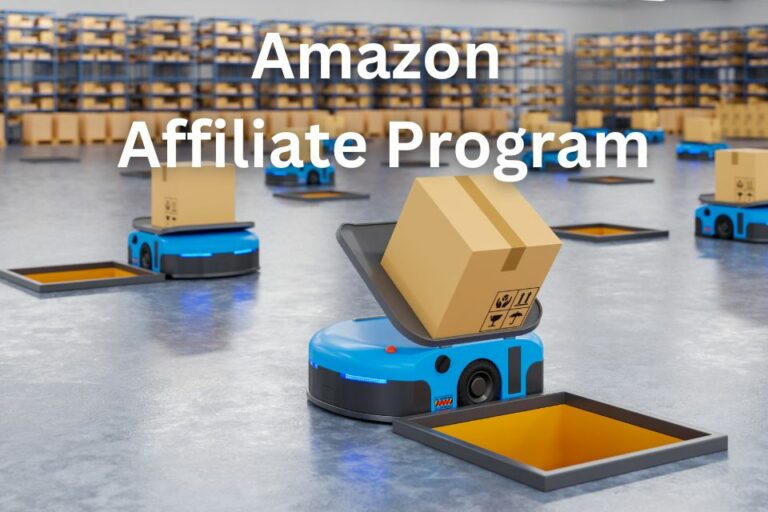Start an Affiliate Marketing Blog in 2025: Step-by-Step Guide
Did you know that the global affiliate marketing industry is projected to reach a staggering $36.9 billion by 2030?
With a compound annual growth rate of 10.1%, there’s never been a better time to start an affiliate marketing business and claim your share of this booming market.

Starting a Profitable Affiliate Marketing Blog in 2024
Mastering SEO Strategies for a Successful 2024 Affiliate Marketing Blog
Key Takeaways
- The affiliate marketing industry is growing at 10.1% annually, reaching $36.9B by 2030
- Successful affiliate blogs require strategic niche selection and proper technical setup
- Content quality and SEO optimization are crucial for long-term success
- Diversified monetization strategies maximize earning potential
- Building an email list is essential for sustainable growth
- Continuous analysis and optimization drive improved performance
What You Need to Know First
Starting an affiliate marketing blog means creating a website where you write about products and earn money when people buy through your links. Simple as that.
Most people overthink this. They spend months planning instead of doing. Don’t be those people.
Here’s what actually matters:
- Pick a topic you know something about
- Choose products that actually help people
- Write stuff people want to read
- Be patient—this takes time
Step 1: Pick Your Blog Topic (15 Minutes)
Your blog needs a focus. Not “everything under the sun”—that’s a recipe for failure.
Think about:
- What do you already know about?
- What problems can you solve?
- What products do you use and love?
Good blog topics:
- Home fitness equipment
- Budget travel gear
- Work-from-home tools
- Pet training products
- Kitchen gadgets for small spaces
Bad blog topics:
- “Lifestyle” (too broad)
- “Everything I like” (no focus)
- “Random thoughts” (nobody cares)
The sweet spot? Pick something specific enough to be an expert, broad enough to write 100+ posts about. Choosing your niche doesn’t have to be complicated.
Step 2: Get Your Domain and Hosting (30 Minutes)
You need two things:
- A domain name (your web address)
- Web hosting (where your blog lives)
Domain Name Tips:
- Keep it short (under 15 characters)
- Make it easy to spell
- Avoid hyphens and numbers
- Use .com if possible
Web Hosting Reality Check:
Don’t cheap out here. Bad hosting = slow site = no readers = no money.
| Hosting Type | Monthly Cost | Good For |
|---|---|---|
| Shared | $3-10 | Just starting |
| VPS | $20-60 | Growing blogs |
| Dedicated | $100+ | Big sites |
Most beginners start with shared hosting. That’s fine. You can always upgrade later. Understanding web hosting helps you make the right choice.
Step 3: Install WordPress (10 Minutes)
WordPress powers 40% of the internet. There’s a reason for that—it works.
Most hosting companies have one-click WordPress installation. Click the button. Follow the prompts. Done.
Basic WordPress Setup:
- Choose a theme (start with free ones)
- Install essential plugins:
- Yoast SEO
- Akismet (spam protection)
- UpdraftPlus (backups)
- Delete the default posts
- Create your main pages:
- About
- Contact
- Privacy Policy
- Affiliate Disclosure
Building a WordPress website from scratch is easier than you think.
Step 4: Join Affiliate Programs (1-2 Hours)
This is where the money part comes in. You need products to promote.
Beginner-Friendly Affiliate Programs:
Amazon Associates
- Pros: Sells everything, trusted brand
- Cons: Low commissions (1-10%)
- Best for: Physical products
ShareASale
- Pros: Lots of merchants, good tracking
- Cons: Interface feels dated
- Best for: Various niches
ClickBank
- Pros: High commissions (up to 75%)
- Cons: Lots of sketchy products
- Best for: Digital products
CJ Affiliate (Commission Junction)
- Pros: Big brands, reliable payments
- Cons: Strict approval process
- Best for: Established blogs
Start with 2-3 programs max. You can always add more later. Joining the best affiliate networks gives you more options.
Step 5: Create Your First Content (2-4 Hours)
Time to write. But not just any writing—strategic writing that ranks and converts.
Your First 10 Posts Should Include:
- “Best [Product] for [Specific Use]” – These convert like crazy
- “[Product] vs [Product]” – Comparison posts
- “How to [Solve Problem]” – Tutorial content
- “[Product] Review” – Honest reviews
- Ultimate guides – Comprehensive resources
Content Structure That Works:
Introduction (50-100 words)
- State the problem - Promise the solution
Main Content (1,500-2,500 words)
- Break into sections - Use short paragraphs - Add images/screenshots - Include pros and cons
Conclusion (100-150 words)
- Summarize key points - Clear call-to-action Creating SEO-friendly blog posts helps you rank faster.
Step 6: SEO Basics (Ongoing)
SEO isn’t magic. It’s just giving Google what it wants.
On-Page SEO Checklist:
- Target keyword in title
- Keyword in first 100 words
- Use headers (H2, H3) logically
- Add alt text to images
- Internal links to related posts
- External links to authority sites
- Meta description under 160 characters
Off-Page SEO Reality:
Links still matter. But don’t buy them. Don’t spam them. Earn them by:
- Creating genuinely useful content
- Guest posting on relevant blogs
- Building relationships with other bloggers
Understanding SEO best practices will save you years of trial and error.
Step 7: Build Your Email List (Day One)
Email is your insurance policy. Social media platforms die. Google changes algorithms. But your email list? That’s yours forever.
Simple Email Strategy:
-
Choose an email service:
- ConvertKit (best for bloggers)
- GetResponse (good automation)
- MailChimp (okay for beginners)
-
Create a lead magnet:
- Cheat sheet
- Quick guide
- Resource list
- Email course
-
Add opt-in forms:
- End of posts
- Sidebar
- Pop-up (don’t be annoying)
Building an email list for affiliate marketing is non-negotiable.
The Money Part: How Affiliate Marketing Actually Works
Let’s talk numbers. Real numbers.
Typical Affiliate Commission Rates:
| Product Type | Commission Range | Example |
|---|---|---|
| Physical products | 1-10% | Amazon |
| Software | 20-40% | Web hosting |
| Digital courses | 30-75% | Online training |
| Services | 15-30% | Travel booking |
Income Reality Check:
Month 1-3: 0−100(mostly0)
Month 4-6: 100−500∗∗Month7−12:∗∗500-2,000
Year 2+: $2,000-10,000+
These aren’t guarantees. Some make more. Many make less. How quickly can you make money with affiliate marketing? The truth might surprise you.
Common Mistakes That Kill Blogs
Mistake #1: Promoting Garbage Products
If you wouldn’t buy it, don’t promote it. Your reputation matters more than a quick commission.
Mistake #2: Writing for Search Engines Only
Google’s smart now. Write for humans first. The SEO follows naturally.
Mistake #3: Giving Up Too Soon
Most blogs fail because people quit after 3 months. Success takes 12-18 months minimum.
Mistake #4: Ignoring Mobile Users
Over 50% of web traffic is mobile. If your site sucks on phones, you’re dead.
Mistake #5: No Disclosure
The FTC requires affiliate disclosures. Don’t hide them. Be transparent.
Common affiliate marketing mistakes can tank your blog before it starts.
Content Strategy That Actually Works
Forget posting daily. Quality beats quantity every time.
The 80/20 Content Rule:
- 80% helpful, non-promotional content
- 20% product reviews and comparisons
Content Calendar Reality:
Week 1: Research and outline
Week 2: Write 2 epic posts
Week 3: Promote existing content
Week 4: Update old posts
This schedule is sustainable. You won’t burn out. Your content stays fresh.
Developing a long-term content strategy keeps you consistent.
Tools You Actually Need (Not the Fluff)
Free Tools That Matter:
Google Analytics – Track what works
Google Search Console – See how you rank
Canva – Create images
Grammarly – Catch stupid mistakes
Paid Tools Worth It:
Ahrefs or SEMrush (99/month)−Keywordresearch∗∗ConvertKit∗∗(29/month) – Email marketing
WP Rocket ($49/year) – Speed optimization
Start free. Upgrade when you’re making money. Essential blogging tools can wait until you need them.
Traffic Sources That Convert
Organic Search (Best Long-Term)
- Takes 6-12 months
- Free traffic forever
- Highest conversion rates
Pinterest (Underrated)
- Great for visual niches
- Can drive traffic immediately
- Less competitive than Google
YouTube (Video = Trust)
- Embed videos in posts
- Second largest search engine
- Builds authority fast
Paid Ads (Advanced Only)
- Facebook/Instagram ads
- Google Ads
- Native advertising
Start with one traffic source. Master it. Then add another. Using social media for affiliate marketing works when done right.
The Technical Stuff (Keep It Simple)
Site Speed Matters:
- Use quality hosting
- Compress images
- Install caching plugin
- Minimize plugins
Mobile Optimization:
- Responsive theme
- Readable fonts
- Clickable buttons
- Fast loading
Security Basics:
- SSL certificate (usually free)
- Strong passwords
- Regular backups
- Security plugin
Optimizing site performance isn’t optional anymore.
Building Authority (The Long Game)
Become the Go-To Resource:
- Deep dive into topics – Surface-level content is dead
- Update regularly – Keep information current
- Engage with readers – Answer comments, emails
- Network with others – Guest post, collaborate
- Stay in your lane – Don’t chase every trend
Authority takes time. There’s no shortcut. But once you have it? Money follows.
Scaling Your Blog Business
When You’re Making $1,000/Month:
Reinvest in:
- Better hosting
- Premium tools
- Content writers
- Virtual assistant
Focus on:
- Higher-paying affiliate programs
- Creating your own products
- Building multiple traffic sources
- Email marketing optimization
Scaling an affiliate marketing business requires systems, not more hours.
The Reality Check
Starting an affiliate marketing blog isn’t:
- Get rich quick
- Passive income (at first)
- Easy money
- Set and forget
It is:
- A real business
- Hard work upfront
- Delayed gratification
- Worth it long-term
Most people want the result without the work. That’s why most blogs fail.
Your Next Steps (Do These Today)
- Pick your niche – Stop overthinking
- Buy hosting and domain – Just start
- Install WordPress – It’s not hard
- Write your about page – People buy from people
- Publish your first post – Perfect is the enemy of done
The best time to start was yesterday. The second best time is now.
Final Thoughts
Building an affiliate marketing blog is simple but not easy. You’ll face challenges. You’ll want to quit. Everyone does.
The difference between successful bloggers and everyone else? They kept going when it got hard.
Your blog won’t be perfect at first. That’s fine. You’ll learn by doing. You’ll improve over time. But you have to start.
Stop reading about it. Stop planning. Stop waiting for the perfect moment.
Start your blog today. Write terrible first posts. Make mistakes. Learn from them. Keep going.
In a year, you’ll either have a growing blog making money or another year of excuses. Your choice.
Ready to dive deeper into affiliate marketing? The journey starts with a single post.
Remember: Success in affiliate marketing isn’t about tricks or hacks. It’s about providing value, building trust, and playing the long game. Start today. Stay consistent. The results will follow.
References
- LinkedIn: How Do I Start Blogging For Affiliate Marketing | 6 Steps 2021
- Shopify: Affiliate Marketing for Beginners: Your Startup Guide (2023)
- Affiliate Marketer Training: How To Start An Affiliate Marketing Blog Step-By-Step
- Influencer Marketing Hub: The Ultimate Guide to Affiliate Marketing: Beginner to Advanced
- ResellerClub: A Step-by-Step Guide Creating a Blog for Affiliate Marketing
I’m Alexios Papaioannou, an experienced affiliate marketer and content creator. With a decade of expertise, I excel in crafting engaging blog posts to boost your brand. My love for running fuels my creativity. Let’s create exceptional content together!










